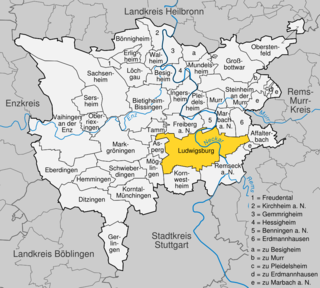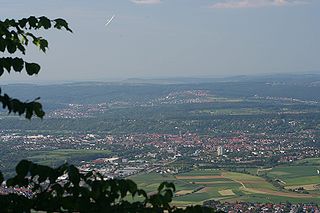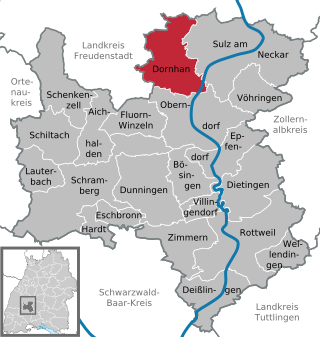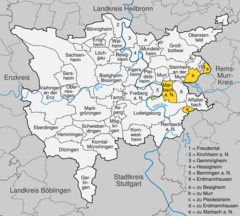Landkreis Heilbronn is a Landkreis (district) in the north of Baden-Württemberg, Germany. Neighboring districts are Neckar-Odenwald, Hohenlohe, Schwäbisch Hall, Rems-Murr, Ludwigsburg, Enz, Karlsruhe and Rhein-Neckar. In the centre of it is the free-city of Heilbronn, which is its own separate administrative area.
Esslingen is a Landkreis (district) in the centre of Baden-Württemberg, Germany. Neighboring districts are Rems-Murr, Göppingen, Reutlingen, Böblingen and the district-free city Stuttgart.
Landkreis Ludwigsburg is a Landkreis (district) in the middle of Baden-Württemberg, Germany. Neighboring districts are Heilbronn, Rems-Murr-Kreis, the district-free city Stuttgart, and the districts Böblingen and Enz-Kreis.

Ludwigsburg is a city in Baden-Württemberg, Germany, about 12 kilometres (7.5 mi) north of Stuttgart city centre, near the river Neckar. It is the largest and primary city of the Ludwigsburg district with about 88,000 inhabitants. It is situated within the Stuttgart Region, and the district is part of the administrative region (Regierungsbezirk) of Stuttgart.

Fellbach is a mid-sized town on the north-east edge of Stuttgart in Baden-Württemberg, Germany. With a population of approximately 45.430 as of December 2020 is the second largest town in the District Rems-Murr-Kreis. The area of the town is 27.7 km2 (10.7 sq mi).

Affalterbach is a municipality in the Ludwigsburg district in Baden-Württemberg, Germany.

The Murr is a river in Baden-Württemberg, Germany, right tributary of the Neckar. The river gave its name to a small town on its banks, Murr, and to the Rems-Murr-Kreis district, which was also named after the river Rems, which runs roughly parallel to the south of the Murr.

Kirchheim unter Teck is a town in Baden-Württemberg, Germany, in the district of Esslingen. It is located on the small river Lauter, a tributary of the Neckar. It is 10 km near the Teck castle, approximately 35 kilometres southeast of Stuttgart. It is the fourth city in the Esslingen district, forming a district centre for the surrounding communities.

Weinstadt is a town in the Rems-Murr district, in the state of Baden-Württemberg, Germany. It is located in the Rems Valley approximately 15 km east of Stuttgart. Its population in 2012 was 25,998.

Ebersbach is a town in the district of Göppingen in Baden-Württemberg, in southern Germany.

Freiberg am Neckar is a town in the district of Ludwigsburg, Baden-Württemberg, Germany. It is situated on the left bank of the Neckar, 18 km north of Stuttgart, and 4 km north of Ludwigsburg.

Beilstein is a town in the district of Heilbronn in Baden-Württemberg in southern Germany. It is 14 kilometres (9 mi) southeast of Heilbronn. Beilstein is on the Württemberg wine route.

Dornhan is a town in the district of Rottweil, in Baden-Württemberg, Germany. It is situated in the eastern Black Forest, 14 km southeast of Freudenstadt.

Murr is a municipality in the district of Ludwigsburg, Baden-Württemberg, Germany. It is situated on the river Murr, 2 km upstream from its confluence with the Neckar and about 9 km northeast of Ludwigsburg.

Erdmannhausen is a town in the district of Ludwigsburg in Baden-Württemberg in Germany.

Erligheim is a municipality in the district of Ludwigsburg in Baden-Württemberg in Germany.

Ingersheim is a municipality in the district of Ludwigsburg in Baden-Württemberg in Germany, belonging to the Stuttgart Region.

Oberstenfeld is a municipality in the district of Ludwigsburg in Baden-Württemberg in Germany. It is located about 40 km north of Stuttgart.
The Backnang–Ludwigsburg railway is a line on the northern edge of the Stuttgart region in the German state of Baden-Württemberg, linking Backnang and Ludwigsburg. The Backnang–Bietigheim line was opened in 1879 as a branch of the Murr Valley Railway from Waiblingen to Hessenthal and left the current route at Beihingen-Heutingsheim. The section between Beihingen-Heutingsheim and Bietigheim was damaged during the Second World War and was never returned to operation.
Großheppach is a town district or Stadtteil within the town of Weinstadt in Baden-Württemberg, Germany. The Stadtteil, which lies in the Rems Valley, is home to 4,398 residents. Großheppach and Kleinheppach are located along the Heppach, a small stream that flows into the river Rems. The village of Großheppach, the Weiler Gundelsbach, and the homestead Wolfshof belong to the Stadtteil, which has borders that exactly match those of the earlier municipality of Großheppach. Its neighbor Kleinheppach, on the other hand, is now part of the municipality of Korb.






















